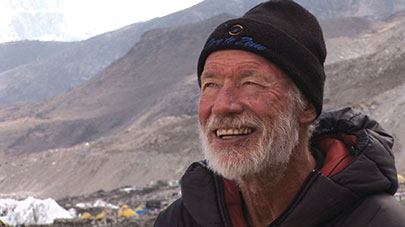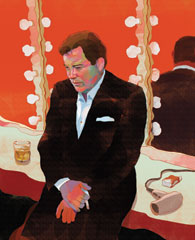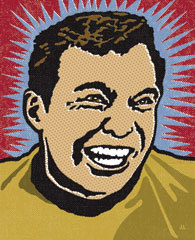Newsbites
Mountain Man

Werner Berger at his base camp, en route to becoming the oldest North American to conquer Mount Everest.
Courtesy of Werner Berger
On May 22, 69-year-old Werner Berger, MSc(A)'63, became the oldest North American to summit Mount Everest. Then, after soaking in the hard-won view from the top of the world ("There really aren't any words to describe it"), he flew a kite.
"We had a wonderful breeze," recalls the South Africa-born Berger, a business consultant, "but it was a little on the gusty side." The kite, multicoloured on one side and white on the other, is symbolic of a goal that dwarfs even the sizable achievement of climbing Everest: world peace. "It's rather ridiculous that everybody wants peace," Berger says, "but we don't get any closer to achieving it."
Next August (08/08/08, to be precise), Berger plans to summit Kilimanjaro for the third time in his 15-year mountaineering career — and he's bringing his peace kite. Joining Berger will be media, dignitaries and, most importantly, young envoys (aged 18 to 25) from feuding countries. Berger has already confirmed the participation of Israeli and Palestinian youths, and hopes many other countries will be represented. "It will be the kick-off for an ongoing movement for peace," he explains. "It's a bit of a pipe dream, but we've set the date."
In the meantime, Berger plans to edit his first film. Framed by the story of his Everest climb (a cinematographer was part of the climbing team), the documentary will explore what Berger believes to be a crisis period for North American health.
"Sixty-six per cent of people are overweight," he explains. "Twenty-five per cent are clinically obese. Eight out of 10 people die of degenerative disease, not of old age."
Berger has long believed in the healthful benefits of sport. While studying at McGill, he pole vaulted and played rugby.
He even met his ex-wife Janice, BN'63, during the annual geologists-versus-nurses hockey game. (She was a goalie, he was a winger.) "But physical education is just part of it," he's quick to stress. "Health is the important thing, and North American health is not in great shape."
Berger has a third project on the back burner. There are currently three Everest conquerors, all Japanese, who are his senior. (The oldest is 71.) "In 2010," he says, "if nobody older has upstaged me, I'll go back to Everest." The climb, however, won't be about changing the world.
"This time," he cheerily admits, "it's strictly ego."
The Many Shades of Shatner

Zina Saunders

Sean Kenney

Mark Dulmadge

Nick Dewar
Illustration, to twist a phrase, is the sincerest form of flattery.
To celebrate the 76th birthday of William Shatner, BCom'52, Calgary's UPPERCASE Gallery commissioned 76 illustrators, painters and sculptors to craft impressions of the iconic Emmy winner. The project stemmed from a cross-Canada round trip that curator Janine Vangool and her husband took two summers ago; the couple repeatedly listened to Has Been, Shatner's autobiographical 2004 album, and grew enchanted by the actor's winking bluster. "When we got home, I started researching what Shatner has said about his career," recalls Vangool. "I really started to appreciate his self-deprecating humour and his awareness of himself as a character. When I learned he was going to turn 76, I suddenly imagined having 76 Shatners in his honour."
Many of the works in The Shatner Show portrayed the Montreal native in the guise of his most famous role, Captain Kirk from Star Trek. Some artists drew inspiration from Shatner's much-maligned singing career, while others inflated the great man's mythology to engulf pivotal moments in Canadian history (such as the time William Shatner drove the Last Spike of the Canadian Pacific Railway).
When the show opened in June, Vangool offered Shatner his pick of the original artwork; he opted for realism over wacky, choosing a sombre backstage portrait by New York artist Zina Saunders.
Shatner didn't attend the show, nor attempt to exercise creative control, but he did give it his blessing. "Some creators love a great sunset; some have in mind my bloodshot eyes," he noted in his official endorsement. "Who am I to stand in the way of all these fine artists and artisans who want to use my lumpy, aging face for inspiration?"
The Shatner Show closed in August, but lives on in a 128-page, full- colour hardcover book, available through www.theshatnershow.com.


